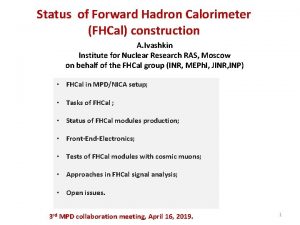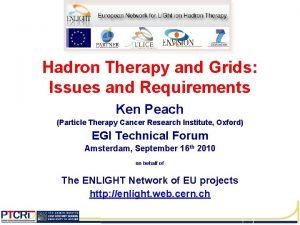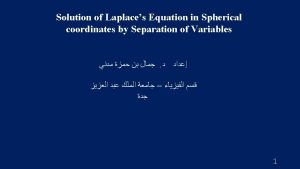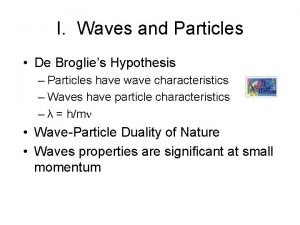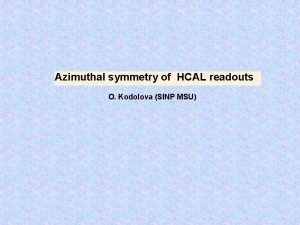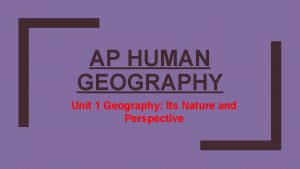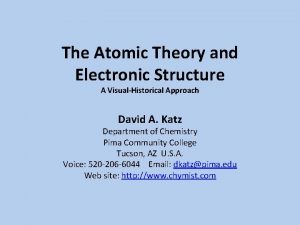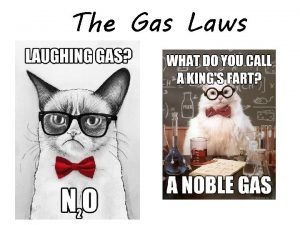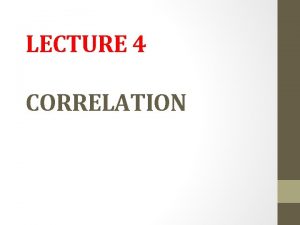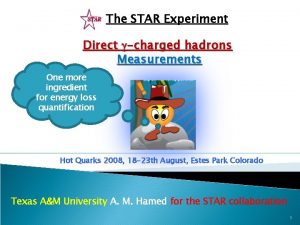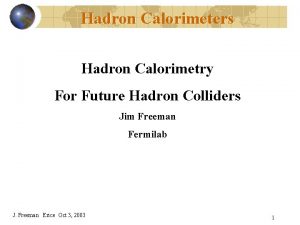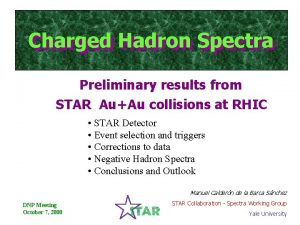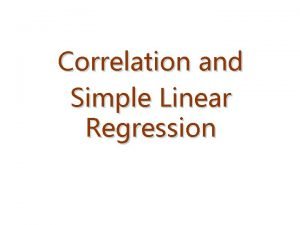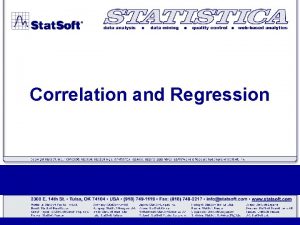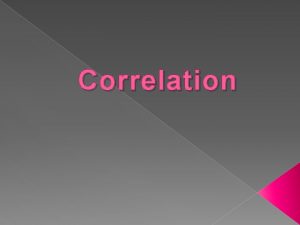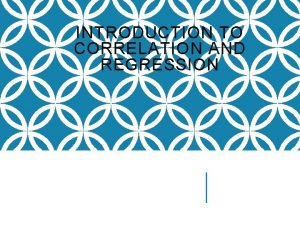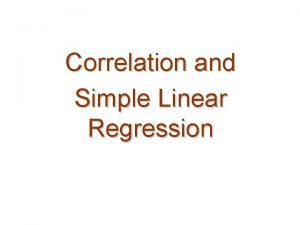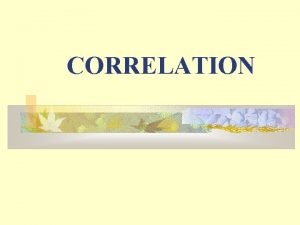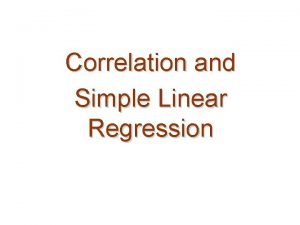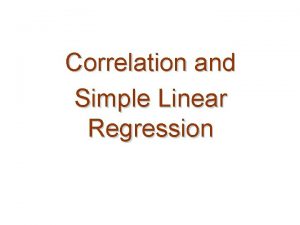The STAR Experiment Direct charged hadron azimuthal correlation



















- Slides: 19

The STAR Experiment Direct -charged hadron azimuthal correlation measurements Table of Contents: q. Introduction q. Analysis q. Results q. Summary 34 th International Conference on High Energy Physics (ICHEP 2008) Texas A&M University A. Hamed for the STAR collaboration 1

Introduction: Degrees of freedom The space-time evolution of a relativistic heavy-ion collision Ordinary nuclear matter q. Nuclear density 0 ~ 0. 15 nucleons/fm 3 q. Specific volume ~ 6 fm 3 Small size “ Very short alife fewtime fermi in diameter” -23 s. 5 -10 x 10 q. Typical hadronic volume ~ 1 -3 fm 3 q. The average inter. Nucleon distance in the nucleus ~ 1. 8 fm Ø One must expect in case of nuclear density greater than 3 0 the nucleons to overlap, and their individuality to be lost. J. C. Collins, M. J. Perry, Phys. Rev. Lett. 34 1353(1975). ØOne of the most important characteristics is the medium color charge density, which might lead to understand the medium dynamics. How to probe the color charge density? A. Hamed STAR Experiment ICHEP 08 Philadelphia, PA July 29 th -August 5 th. 2

Introduction: Hard probes- I ØLike QED the charge density of the medium can be probed by its effect on the propagation of a fast particle. §Hard processes Very short life time q. Take place at early time of collisions Hard Scattering in the medium )) , E h/ z) a versus ( E p+p or peripheral Au+Au D v(ac h/ (z a , P Compare Hard Scattering in vacuum-QCD Study the particles distribution in fractional energy. D med Fragmentation Function a good probe of the medium. Central Au+Au Gluon radiation is induced by multiple scattering A particle distribution in fractional energy is softened in the medium . How the hard probes can be used to measure the modification on the FF? 3 A. Hamed STAR Experiment ICHEP 08 Philadelphia, PA July 29 th -August 5 th.

Introduction: Hard probes - II Jet-like azimuthal correlations “conservation of linear momentum” momentum E Eparton trigger hadron PRL. 91, 072304 (2003) Central Au+Au Trigger How much energy is lost in here? ? Near side 0 Associated particles Associated 4 < p. T, trig < 6 Ge. V/c particles 2 < p. T, assoc < p. T, trig Away side Background is subtracted p+p di-jet Au+Au ? ØIn the near-side p+p, d+Au, and Au+Au are similar while in the away-side “back-to-back” Au+Au is strongly suppressed relative to p+p and d+Au. An access to the parton initial energy is required to quantify the energy lost 4 A. Hamed STAR Experiment ICHEP 08 Philadelphia, PA July 29 th -August 5 th.

Introduction: Jet-energy calibration “Direct ” “Mid-rapidity” zero near-side yield for direct photons Fast Detector “Calorimeter” Leading particle “trigger” Background 0 P Color charge density? How much energy is lost in the medium? üDue to fragmentation full jet reconstruction is required to access the initial parton energy OR x. P Direct photons No access to the escape from the parton initial energy medium without any further interactions FF is softened P in the medium Associated particles get the initial parton energy with a powerful alternative method: “Direct -hadron azimuthal correlations” How to measure direct -hadron azimuthal correlations? A. Hamed STAR Experiment ICHEP 08 Philadelphia, PA July 29 th -August 5 th. 5

Analysis: Analysis technique üCorrelate photon candidate “triggers” with “associated tracks” p. T, trig > 8 Ge. V/c Charged hadrons BEMC TPC One tower out of 4800 towers (0. 05 x 0. 05) 2 m ~2. 2 0 Eπ 0 No track with p > 3 Ge. V/c points to the trigger tower Eγ = Eparton Use triggers to explore fragmentation functions in p+p and Au+Au is 180° ‹E p am e B ax arto n BEMC: Barrel Electro-Magnetic Calorimeter TPC: Time Projection Chamber Associated charged particles “ 3 <p. T, assoc < 8 Ge. V/c” Full azimuthal coverage How to distinguish between 0/ ? A. Hamed STAR Experiment ICHEP 08 Philadelphia, PA July 29 th -August 5 th. 6

Analysis: Shower Shape Analysis The two photons originated from 0 hit the same tower at p. T>8 Ge. V/c STAR Shower Maximum Detector is embedded at ~ 5 x 0 between the lead-scintillator layers “BEMC” i : strip energy ri : distance relative to energy maxima 7 RM 0 Use the shower-shape analysis to separate the two close photons shower from one photon shower. 7 A. Hamed STAR Experiment ICHEP 08 Philadelphia, PA July 29 th -August 5 th.

Results: Effect of shower-shape cut Centrality Background is not subtracted Vacuum QCD Medium effect o. The away-side correlation strength is suppressed compared to pp and peripheral Au+Au. o. The -rich sample has lower near-side yield than 0 but not zero. -sample is not pure direct ! How about the 0 ? A. Hamed STAR Experiment ICHEP 08 Philadelphia, PA July 29 th -August 5 th. 8

Results: Comparison of 0 -triggered yields to charged-hadron triggered yields Completely different data set from different RHIC runs, different detectors were involved in the analysis too. Associated yields per trigger This analysis Surface bias PRL 97 162301 (2006). ? Central Au+Au üNear side: Yields are similar for p+p and central Au+Au üAway side: Yields show big difference between p+p and central Au+Au ü 0 -charged and charged-charged results are consistent. 0 sample is pure. 9 A. Hamed STAR Experiment ICHEP 08 Philadelphia, PA July 29 th -August 5 th.

Results: Method of extract direct associated yield O(αs 2α(1/αs+g)) Extraction of direct away-side yields near R=Y -rich+h/Y 0+h üAssume no near-side yield for direct then the away-side yields per trigger obey away 0 Y +h = (Y -rich+h - RY 0+h )/(1 -R) This procedure removes correlations due to contamination (asymmetric decay photons+fragmentation photons) with assumption that correlation is similar to 0 – triggered correlation at the same p. T. 10 A. Hamed STAR Experiment ICHEP 08 Philadelphia, PA July 29 th -August 5 th.

Results: Fragmentation function of direct triggers and 0 triggers Associated yields per trigger Direct 0 Differences between and 0 triggers 0 -triggers are resulted from higher parton energy than -triggers. 0 -triggers are surface biased. Color factor effect. üThe away-side yield per trigger of direct triggers shows smaller value compared to 0 triggers which is consistent with partons loose energy “dense medium” and then fragment. What is the medium color charge density? A. Hamed STAR Experiment ICHEP 08 Philadelphia, PA July 29 th -August 5 th. 11

Results: Medium effect on fragmentation function Icp(z. T) = 1 D 0 -10% (z. T) D 40 -80% (z. T) D (z ) IAA(z. T) = AA T Dpp (z. T) Data points trig 8 < p. T < 16 Ge. V/c assoc If there is no medium effect p. T > 3 Ge. V/c Strong medium effect trig 7 < p. T < 9 Ge. V/c STARPreliminary q Icp agrees with theoretical predictions. üMore precision is needed for the measurements to distinguish between different color charge densities. üWithin the current uncertainty in the scaling the I of direct and 0 are similar. cp 12 A. Hamed STAR Experiment ICHEP 08 Philadelphia, PA July 29 th -August 5 th.

Summary and Outlook üFirst result of -jet azimuthal correlations and fragmentation function D(z. T) in Au. Au at RHIC energy is reported. üAway-side yield for direct photons is significantly suppressed in heavy ion events. Suppression level agrees with theoretical expectations. üAll results of 0’s near and away-side associated particle yields shows consistency with that of charged hadron triggers. üLarge luminosity at RHIC enables these measurements. Expect reduced uncertainties from further analysis and future runs. 13 A. Hamed STAR Experiment ICHEP 08 Philadelphia, PA July 29 th -August 5 th.

Thank you for your attention and many thanks to all STAR collaborators 14

Backup slides 15

Limitations of the shower shape cut Shower Shape Cuts: Reject most of the 0’s. But do not reject photons from: highly asymmetric 0 decay. 10% of all 0 with p. T > 8 Ge. V/c ’s - similar level of background as asymmetric 0 fragmentation photons 10% of inclusive at intermediate p. T in p+p ~30 -40% of direct at PT > 8 Ge. V/c. 16 A. Hamed STAR Experiment ICHEP 08 Philadelphia, PA July 29 th -August 5 th.

Luminosity Projections -jet yield ET > 15 Ge. V Away-side hadrons PRL 98 (2007) 212301 Phys. Rev. C 74 (2006) 034906 Projection for statistical uncertainties in γ-hadron suppression as the integrated luminosity increases. Projection is for ET γ> 15 Ge. V, associated particle p. T from 4 -6 Ge. V/c. More precision is required to nail down the medium density A. Hamed STAR Experiment ICHEP 08 Philadelphia, PA July 29 th -August 5 th. 17

On the transverse shower profile cut Etotal ∑i i ri 1. 5 ØTwo photons ( 0) produce a more diffuse shower than single photons ( ) ØWider shower has small value of such quantity 7 RM 0 Two dimensional shower shape i : strip energy Shower shape cut for 0 Shower shape cut for Very pure sample of 0 ri : distance relative to energy maxima selection is not tight rich sample 18 A. Hamed STAR Experiment ICHEP 08 Philadelphia, PA July 29 th -August 5 th.

Method of extract direct associated yield Away-side Y -rich+h=1/N -rich(N -rich+h) =1/N -rich [N 0+h+N +h] =(N 0+h/N -rich)+(N +h/N -rich) =(N 0/N -rich)*N 0+h/N 0+(N /N -rich)*N +h/N Solve for Y +h Y 0+h Y +h=(N -rich/N )[Y -rich+h-(N 0/N -rich)*Y 0+h] Near-side 3 unknowns N -rich, N 0, and N. Y -rich+h=(1/N -rich)*N -rich+h N 0/N -rich=Y -rich+h/Y 0+h=R Substitute in 1 =(1/N -rich)*N 0+h =(N 0/N -rich)*Y 0+h N +h=0 Y +h=(N -rich/N )[Y -rich+h-R*Y 0+h] 1 -R=1 -(N 0/N -rich)=(N -rich-N 0)/N -rich=N /N -rich 2 1/(1 -R)=N -rich/N (N -rich-N 0)=N Substitute in 2 1 Y +h=[Y -rich+h-R*Y 0+h]/1 -R A. Hamed STAR Experiment ICHEP 08 Philadelphia, PA July 29 th -August 5 th. 3 19
 Star of wonder star of night star of royal beauty bright
Star of wonder star of night star of royal beauty bright Positive correlation versus negative correlation
Positive correlation versus negative correlation No correlation gif
No correlation gif Hadron calorimeter
Hadron calorimeter Hadron collider
Hadron collider Hadron collider
Hadron collider Hadron
Hadron Hadron
Hadron Laplacian in spherical coordinates
Laplacian in spherical coordinates Azithmal
Azithmal Zumdahl chemistry
Zumdahl chemistry Azimuthal symmetry
Azimuthal symmetry Geospatial data definition ap human geography
Geospatial data definition ap human geography Azimuthal quantum number
Azimuthal quantum number Indirect relationship chemistry
Indirect relationship chemistry Ao* algorithm example
Ao* algorithm example What does star for star events stand for
What does star for star events stand for Hát kết hợp bộ gõ cơ thể
Hát kết hợp bộ gõ cơ thể Bổ thể
Bổ thể



